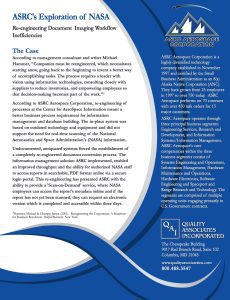ASRC acquires and manages NASA STI (scientific and technical information), dating back to 1962, in Hanover, Maryland. These multiple-page technical reports, some of them very old and delicate, contain both greyscale and color images adding another complication to the conversion process and quality of the files. Searchable images were not available. If a NASA employee requested a copy of a report, that document would have to be printed and shipped to the requestor.
NASA’s requirement to ASRC was to re-engineer the process of the current information management system to provide real-time, electronic delivery of scientific and technical information. The initial step of this requirement was the conversion of over 165,000 existing TIFF files to PDF. ASRC estimated this conversion would take nine to twelve months.
Quality Associates, Inc. (QAI) developed a conversion solution that allowed ASRC to convert over 165,000 TIFF files to PDF in one-third of the estimated time frame. QAI provided a quicker implementation to scanning the daily incoming reports, in real-time. Technology and improvements in scanner features and functionality resulted in higher quality images and enhancements in OCR recognition resulted in a higher quality, more searchable PDF image.
QAI then streamlined a better business process for information management and database building process by decentralizing the capture requirements and providing services such as programming release scripts, providing a quality control mechanism for validation, linking the input of the electronic file to LiveLink. The final process architecture is a distributed scanning model, which improved efficiencies in the capture process.
The technology and integration services QAI provided resulted in an efficient process for ASRC to meet the real-time scanning requirements and address the color and greyscale image component. ASRC now benefits from a closed-loop workflow process while eliminating much of the manual document shuffling and reducing printing and shipping costs. Improved throughput has lead to a better use of human resources and has resulted in an increase in throughput.


